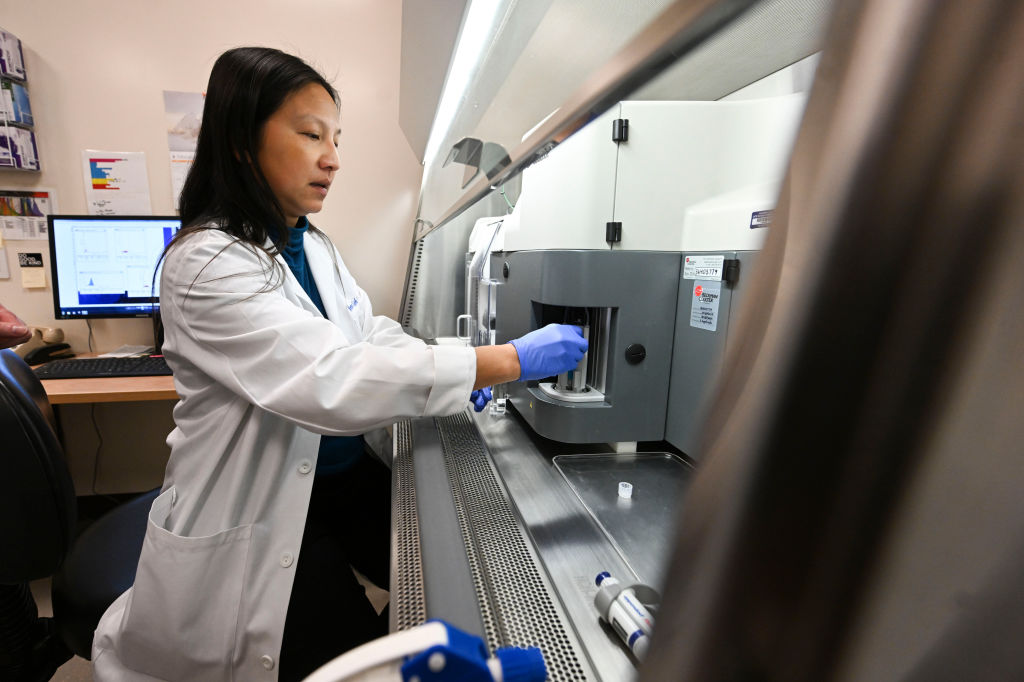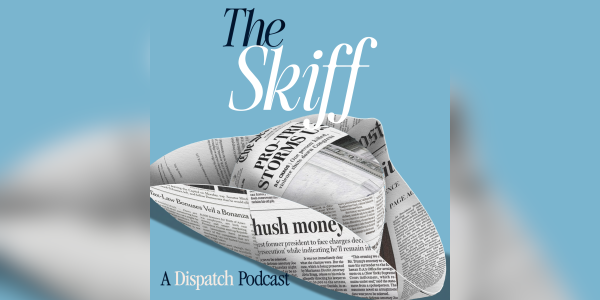Happy Wednesday! During a recent livestream on Instagram, Rep. Alexandria Ocasio-Cortez accused the Trump administration of attempting to “overwhelm” the public with a “constant” barrage of news developments. We’ll let today’s Quick Hits speak for themselves.
Quick Hits: Today’s Top Stories
- Marc Fogel, an American teacher who was arrested in 2021 and convicted in 2022 on politically motivated drug trafficking charges, was freed and returned to the United States on Tuesday after serving more than three years in Russian prison. The Pennsylvanian was formally declared “wrongfully detained” by the U.S. State Department in December following years of advocacy by his family members, who noted that his 14-year sentence—for the possession of a half-ounce of medical marijuana—was harsher than the typical punishment handed down to large-scale drug traffickers and violent offenders. The White House said Fogel’s release followed the negotiation of an “exchange” by special envoy Steve Witkoff and other administration officials, though details of the deal have not yet been made public.
- Israeli Prime Minister Benjamin Netanyahu said Tuesday that his country will resume fighting in the Gaza Strip if Hamas fails to release hostages by noon on Saturday. In the video address—which followed President Trump’s demand that the Palestinian terrorist group release all of the remaining abductees by this weekend—Netanyahu didn’t specify whether he was referring to all of the hostages or only those who had been previously slated for release this week before Hamas on Monday threatened to upend the ceasefire deal. Meanwhile, Jordan’s King Abdullah II said Tuesday that his country would accept 2,000 children from Gaza. The announcement, during an Oval Office meeting with Trump, followed the president’s recent call for the relocation of Palestinians from the war-torn enclave.
- Canadian Prime Minister Justin Trudeau on Tuesday announced plans to retaliate against President Donald Trump’s imposition of 25 percent tariffs on all steel and aluminum imports, with no exemptions for any country. Trudeau described the levies as “entirely unjustified,” but stopped short of outlining specific countermeasures. Speaking for the European Union, another U.S. trade partner affected by the move, European Commission President Ursula Von der Leyden also vowed that the “unjustified tariffs” would “trigger firm and proportionate countermeasures.” The sweeping duties are set to take effect on March 12.
- The United States and the United Kingdom on Tuesday declined to join 60 countries—including China, India, and France—in signing a joint declaration on artificial intelligence safety and regulation at a summit in Paris. The U.S.’s decision followed a speech by Vice President J.D. Vance at the gathering, during which he expressed concerns about an overly “risk-averse” approach to the emerging technology. The U.K., meanwhile, said that the statement—which pledges an “open,” “ethical,” and “inclusive” approach to AI development—failed to “sufficiently address harder questions around national security and the challenge AI poses to it.”
- President Trump issued an executive order Tuesday extending more power to Elon Musk’s Department of Government Efficiency, or “DOGE.” The directive gives DOGE oversight on hiring and requires federal agencies to work with the team to “eliminate waste, bloat, and insularity” through “large-scale” personnel reductions, consistent with applicable laws. Appearing alongside Trump in the Oval Office on Tuesday, Musk outlined his overhaul plan and vowed to eliminate alleged large-scale fraud within the federal government.
- Multiple outlets reported Tuesday that the Trump administration had moved to fire Paul Martin, the inspector general at the State Department and the Agency for International Development (USAID). Martin’s dismissal came a day after the watchdog’s release of a report detailing the negative repercussions of the administration’s efforts to pause USAID’s operations and drastically reduce its personnel. The overhaul “put more than $489 million of food assistance at ports, in transit, and in warehouses at risk of spoilage,” the inspector general found.
- Steve Bannon, onetime adviser to former President Trump, pleaded guilty Tuesday to defrauding donors to a fundraiser to build a southern border wall. Under the plea deal, Bannon will not face any jail time for the scheme, which raised more than $20 million from private donors. Last year, Bannon served four months in federal prison after being found guilty of contempt of Congress for refusing to cooperate with an investigation into the January 6, 2021, Capitol riot.
- President Donald Trump on Tuesday nominated Jonathan McKernan, a former board member of the Federal Deposit Insurance Corporation, to serve as director of the Consumer Financial Protection Bureau. The selection followed recent moves by the administration to halt the independent banking watchdog’s operations and fire its head, Biden appointee Rohit Chopra. Also on Tuesday, Trump nominated financial regulation attorney Jonathan Gould to serve as the comptroller of the currency. Both nominees are subject to Senate approval.
Research Funding Takes a Hit

What’s old is new again this week with President Donald Trump’s executive actions. The administration announced late last week a new cap that would cut billions of research cost funding provided by the National Institutes of Health (NIH) to universities and medical research institutions across the country. The move is nearly identical to a proposal made during the president’s first administration that was shot down by Congress.
With the aid of his DOGE hatchetman Elon Musk, Trump is again pursuing a cap, but this time, the administration is trying to do so without congressional approval. The move already faces a court challenge, and scholars and researchers who work with and study NIH grants argue that such a steep cut would take a sledgehammer to a vital medical research system that is in greater need of scalpel-level reforms.
The NIH announced Friday that effective Monday morning the agency would institute a 15 percent cap on so-called “indirect costs”—research overhead like facilities and administrative (F&A) expenses—across all NIH grants. “This change will save more than $4B a year effective immediately,” the agency said, arguing that universities with huge endowments like Harvard and Yale have excessive indirect cost rates for federal grants compared to grants from private foundations. Musk claimed the high rates are “siphoning off” funds from actual research.
Nearly two dozen states sued the Trump administration to block the move and a federal judge issued a temporary restraining order on Monday to stop the cap from going into effect while the legal challenge proceeds. And the lawsuit appears to be on strong legal footing. In 2018, congressional Republicans, alarmed by Trump’s original attempt to cap indirect costs, added language to the legislation funding the Department of Health and Human Services (HHS) that explicitly preempts the executive branch from unilaterally remaking indirect cost rates.
Still, the reintroduction of the cap has thrown billions of biomedical research funding into question. The NIH is the single largest funder of medical research in the world, with more than 80 percent of the agency’s budget going to external research. In 2023, $9 billion of the approximately $35 billion NIH spent on external research went to cover indirect costs. But analysts say the Trump administration’s claims about those costs betray its misconceptions about how NIH funding works.
Researchers and scientists apply for NIH grants to cover costs directly related to their proposals—think the salaries of the people working on their project, or supplies and equipment solely used for the research. But this funding does not cover things like facilities, labs, administrative support, and equipment at scientists’ host institutions that are used for not only the specific grant project but also other work and activities. These are considered indirect costs and can include everything from the rent, maintenance, and utilities on research buildings to data processing to hazardous waste disposal.
Health research could not be conducted without facilities and some level of administration, but the NIH assesses funding for those kinds of costs separately from grant proposals. The rationale for the different treatment is the challenge of determining what exact portion of shared resources and administrative support an individual grant expends. “If you have thousands of grants, in one institution or many hundreds, you’re not going to be able to figure out what amount of security and computing and all those things go to each grant in some differential way,” Dr. Jeffrey Flier, the former dean of Harvard Medical School, told TMD.
Instead, an office within the Department of Health and Human Services (HHS) reviews institutions’ overall costs necessary to facilitate grant-funded research—which can vary depending on rent and labor costs in different locations and the type of research conducted—and sets an institution-wide indirect cost rate every few years that is then applied on top of individual research grants.
For example, if a researcher at a university applies for a $1 million NIH grant, and the HHS-determined indirect cost rate for the university is 60 percent, then the NIH will provide $1 million to the researcher for his direct project costs and an additional $600,000 to the university as reimbursement for indirect costs. In this scenario, a 60 percent rate would mean that 37.5 percent of the total award goes to indirect costs. Contrary to Musk’s claims, the indirect funding is not subtracted from but added to the research grant money.
University officials also note that grants from private foundations allow for more costs to be considered as directly part of research proposals than the NIH does, reducing the relative indirect cost rate of private grants. “When you compare an NIH grant to a Gates Foundation or Arnold Ventures or Commonwealth Fund, you’re not comparing the same grant,” Ezekiel Emanuel, the vice provost for Global Initiatives at the University of Pennsylvania and a former NIH department chair, told TMD. “Things that are normally in the indirects in the NIH are actually in the grants.”
Indirect costs have long been considered a potential target for reform—the Obama administration considered imposing a flat rate. But the debate over policy changes has suffered for years from what a former HHS official in charge of indirect cost negotiations described more than 30 years ago as the “perennial myths”—namely, that the terms “indirect” or “F&A” describe funds that don’t support research at all.
Scientists and researchers themselves sometimes echo these claims. “Faculty tend to view direct costs as the only real costs of research, with F&A, which for the most part is hidden to them, as an unnecessary subsidy to the university or not rigorously determined,” Dr. Kelvin Droegemeier, a former member of the National Science Board and a White House science policy adviser in the first Trump administration, explained in 2017 congressional testimony on indirect costs. “This leads to the belief that less F&A would mean more funding to support direct costs for research. But of course, such is not the case because less F&A would actually mean that the university could not afford to conduct even as much research as it currently does, and certainly not more.”
Even with current indirect cost rates, institutions still have research funding gaps they cover themselves—over the last few decades, universities have self-funded increasingly larger portions of total research and development spending. Former NIH Director Francis Collins noted back in 2017 when the first Trump administration cap was being discussed that NIH awards don’t cover the full spectrum of costs institutions incur while conducting federally funded research. Despite institutions shouldering more costs, the percentage of total NIH awards going to indirect costs has remained virtually flat at around 27 percent over the last 20 years.
“The idea that this won’t have any effect on the research enterprises at a university or a medical school or a hospital, false,” Emanuel told TMD. “It’s definitely going to undercut the amount of research that can be undertaken.”
An immediate 15 percent cap on indirect costs would cut hundreds of millions of dollars from universities, medical centers, and independent research institutions across the country. The University of Pennsylvania would lose $240 million annually. Stanford University would lose $160 million. Nationwide Children’s Hospital, one of the country’s leading pediatric hospitals and research institutes, would lose $21.5 million. “The government’s support of facilities and administrative costs allows medical research to happen,” David Skorton, the head of the Association of American Medical Colleges, said in a statement on Saturday. “This announcement will mean less research. Lights in labs nationwide will literally go out.”
Smaller research institutions could be the worst hit by the cap. “The most exposed institutions are the nonprofit, independent research institutes,” Pierre Azoulay—a Massachusetts Institute of Technology professor and economist who is currently researching the relationship between indirect cost rates and institutions’ research outputs—told TMD. “They have nothing else but research. They don’t have teaching. They don’t necessarily have large endowments.”
The more an organization’s work is focused on NIH grant-supported research, the higher their indirect cost rate could be since more of their overall costs can be associated with grant-funded research. In some cases, these institutes can have rates of 90 percent. “Without the indirect costs, those institutions cannot exist,” Azoulay added. “And most do extraordinary research.”
Some GOP lawmakers have pushed back on the cap. “A smart, targeted approach is needed in order to not hinder life-saving, groundbreaking research at high-achieving institutions like those in Alabama,” Sen. Katie Britt, an Alabama Republican, said Saturday. The University of Alabama would lose $70 million under a 15 percent indirect cost rate. Sen. Susan Collins described the cap as “arbitrary” and “poorly conceived,” citing the biomedical research institutions in her home state of Maine that would be hurt.
Researchers and commentators have criticized the Trump administration for not taking a more serious and legally sound approach to improving NIH grantmaking. “Should this system be reformed? I’m the first person to say, yes,” Emanuel told TMD. “Do you reform it with a sledgehammer? I’m the first person to say, no.”
“This is actually wasting an opportunity,” Flier said of the administration’s approach, arguing there should be more transparency in how indirect cost rates are calculated to better understand where reforms could improve efficiency. While dean of Harvard Medical School, he presided over the school’s rate negotiations with HHS, but it wasn’t clear to him how the agency actually determined its rate. “I don’t believe we did any negotiating,” Flier said. “We just got told what our rate was.”
Azoulay also argued that more transparency around indirect costs is needed. “I don’t think indirect cost should be some sort of sacred cow that it shouldn’t be possible to think about and possibly reform,” he said. A 2022 HHS Office of the Inspector General audit found instances of the department’s rate-setting division failing to comply with federal regulations and the agency’s own policies for the rate-setting process.
Everyone TMD spoke with also highlighted the cost burden of the mushrooming number of federal rules and regulations with which NIH grantees must comply. Justin Perry, an immunologist and cancer biologist at Memorial Sloan Kettering Cancer Center, told TMD that NIH grant applications and ongoing compliance documentation have grown to hundreds of pages—the vast majority of which has little to do with the substance of the research.
But revising regulations takes time, and Trump and Musk seem more focused on slash-and-burn tactics. An administration with a serious reform agenda may have waited until their pick for NIH director was confirmed before doing anything drastic, for example.
“You don’t come in, take a huge subtractive blow to the research budgets of universities, medical schools, hospitals, institutes and say, ‘now, you’ll figure out how to make it more efficient,’” Flier said. “This is no way to run a government.”
Worth Your Time
- Move over, virtue signaling. There’s a new game in town: “vice signaling,” Thomas Chatterton Williams wrote in The Atlantic. “If a vogue for virtue signaling defined the 2010s and early 2020s, peaking in 2020 during the feverish summer of protest and pandemic—a period in which pronouns in bio, land acknowledgments, black squares, diversity statements, and countless other ethical performances became a form of social capital—something like the exact photonegative of that etiquette has set in now,” he wrote. “The reassertion of brute reactionary power in the dual ascendancy of Donald Trump and Elon Musk has brought us to a cultural tipping point. Virtue be damned: Now we are living in an era of relentless, unapologetic vice signaling.” The left’s relentless push to police social norms has produced an equal, and opposite, backlash, according to Williams: “We had a #MeToo movement characterized by sometimes disproportionate reputational sacrifices; now we have a presidential Cabinet populated by men with credible sexual-assault accusations on their records. The stifling racist/anti-racist binary of the anti-racism movement has led to the wholesale dismantling of DEI initiatives in both the government and the private sector. The insistence that ‘no human is illegal’ has ended with an unconstitutional attempt to retract birthright citizenship… On every single issue that mattered to them, progressives now find themselves in a weaker position than before.”
- The “fog of war”—the idea that active combat makes it almost impossible to accurately assess battlefield conditions—may have been made obsolete by the war in Ukraine, as technology makes it easier than ever before to observe the enemy. “Armies are having to work out how to fight on what is being called the transparent battlefield. The surveillance is layered. Orbiting satellites scan the Earth from space. Tactical drones have ranges of 200km or more. Smaller surveillance drones relay sightings to the operators of first-person view drones (FPVs), which carry a small munition to attack soldiers on the ground. Add a thermal-imaging camera and soldiers can also be spotted at night,” The Economist wrote. “Long-standing tactics have been upended. ‘One of the most obvious’, says Glib Voloskyi, an analyst for Come Back Alive, one of the largest volunteer [organizations] raising money to donate equipment to the Ukrainian armed forces, ‘is that it’s hard to achieve surprise.’ It is also almost impossible to achieve local force superiority: to gather and concentrate troops for an attack. The lethality of fire is greater because targets are easily identified, and artillery adjustments can be made quickly. The transparent battlefield gives the defender the advantage. ‘Offensive operations,’ says Mr Voloskyi, ‘are a really nasty business.’”
Presented Without Comment
CNN: The AP Says It Was Blocked From the Oval Office Over Continuing to Use ‘Gulf of Mexico’
Also Presented Without Comment
Reason: Donald Trump Goes to War Against Universally Hated Paper Straws
Also Also Presented Without Comment
Financial Times: Walt Disney Cuts Diversity Category From Executive Pay Scheme
In the Zeitgeist
The Westminster Kennel Club Dog Show was last night, and there were some very good boys in attendance. But it was ultimately Monty, a 5-year-old giant schnauzer, who beat out the competition to take home Best in Show.
Toeing the Company Line
- In the newsletters: Nick Cataggio wrote (🔒) about Donald Trump’s new spin on the “deep state.”
- On the podcasts: Chris Stirewalt takes over The Remnant to discuss the AI arms race, competition with China, and Trump’s plan to end the Ukraine war with American Enterprise Institute senior fellow Kori Schake.
- On the site: Kevin Williamson writes that American apathy may be Ukraine’s best option, David Drucker covers businesses’ efforts to secure exemptions from Trump’s tariffs, Charles Hilu reports on Lori Chavez-DeRemer’s bid to lead the Department of Labor, and Jonah Goldberg argues Trump’s whirlwind cycle of executive action will eventually slow down.
Let Us Know
Do you agree with Thomas Chatterton Williams’ assessment that “vice signaling” has eclipsed virtue signaling?









Please note that we at The Dispatch hold ourselves, our work, and our commenters to a higher standard than other places on the internet. We welcome comments that foster genuine debate or discussion—including comments critical of us or our work—but responses that include ad hominem attacks on fellow Dispatch members or are intended to stoke fear and anger may be moderated.
With your membership, you only have the ability to comment on The Morning Dispatch articles. Consider upgrading to join the conversation everywhere.